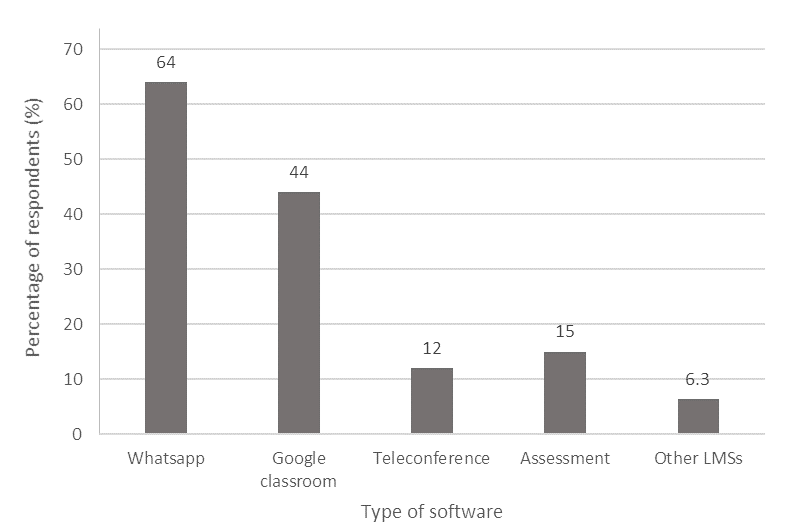Software preference for online learning of science and biology teachers under COVID-19 pandemic
DOI:
https://doi.org/10.22219/jpbi.v7i1.14253Abstract
As measure against the rapid spreading of coronavirus disease 2019 (COVID-19) which now has reached global level, Indonesian government established Large-scale Social Distancing (LsSD). As consequence, learning method used in junior and senior high school is substituted from face-to-face learning in class to online distance learning, including for science and biology. This study was conducted to know software preference used by science and biology junior and senior high school teachers for online learning during LsSD measure. A total of 189 science and biology junior and senior high school teachers from various area had given their response via questionnaire. Data was analyzed using quantitative descriptive method. About 57% respondents had never manage online learning before COVID-19 pandemic while the remaining 43% had experience in managing one before, however almost all managed online learning. Non-paid software used the most (81%) among respondents to manage online science/biology learning. Software types used were social networking (64%) especially WhatsApp, learning management system (LMS) (51%) especially Google Classroom, teleconference applications (12%), and assessment software outside of LMSs (15%). Software chosen were mostly non-paid, easily accessed by all people, already familiar among Indonesian, and its interface were easily mastered.
Downloads
References
Basilaia, G., &Kvavadze, D. (2020). Transition to Online Education in Schools during a SARS-CoV-2 Coronavirus (COVID-19) Pandemic in Georgia. Pedagogical Research. https://doi.org/10.29333/pr/7937
Cobb, S. C. (2009). Social presence and online learning: A current view from a research perspective. Journal of Interactive Online Learning.
Dillon, C. L., &Gunawardena, C. N. (1995). A framework for the evaluation of telecommunications-based distance education. The 17th Congress of the International Council for Distance Education.
Drennan, J., Kennedy, J., &Pisarski, A. (2005). Factors Affecting Student Attitudes Toward Flexible Online Learning in Management Education. Journal of Educational Research. https://doi.org/10.3200/JOER.98.6.331-338
Gugus Tugas Percepatan Penanganan COVID-19. (2020). Peta Sebaran Kasus COVID-19 di Indonesia.
Kapasia, N., Paul, P., Roy, A., Saha, J., Zaveri, A., Mallick, R., …Chouhan, P. (2020). Impact of lockdown on learning status of undergraduate and postgraduate students during COVID-19 pandemic in West Bengal, India. Children and Youth Services Review. https://doi.org/10.1016/j.childyouth.2020.105194
Kementerian Pendidikan dan Kebudayaan Republik Indonesia. (2020). Surat Edaran Menteri Pendidikan dan Kebudayaan Republik Indonesia Nomor 35952/MPK.A/HK/2020. Mendikbud RI.
Made Yeni Suranti, N. (2020). Variations of Models and Learning Platforms for Prospective Teachers During the COVID-19 Pandemic Period. Indonesian Journal of Teacher Education.
Muilenburg, L. Y., &Berge, Z. L. (2005). Students Barriers to Online Learning: A factor analytic study. Distance Education. https://doi.org/10.1080/01587910500081269
Pemerintah Republik Indonesia. (2020). Peraturan Pemerintah Republik Indonesia Nomor 21 Tahun 2020.
Presiden Republik Indonesia. (2020). Keputusan Presiden Republik Indonesia Nomor 12 Tahun 2O2O Tentang Penetapan Bencana Nonalam Penyebaran Corona Virus Disease 2019 Sebagai Bencana Nasional.
Prior, D. D., Mazanov, J., Meacheam, D., Heaslip, G., &Hanson, J. (2016). Attitude, digital literacy and self efficacy: Flow-on effects for online learning behavior. Internet and Higher Education. https://doi.org/10.1016/j.iheduc.2016.01.001
Ractham, P., &Firpo, D. (2011). Using social networking technology to enhance learning in higher education: A case study using facebook. Proceedings of the Annual Hawaii International Conference on System Sciences. https://doi.org/10.1109/HICSS.2011.479
Thoms, B., &Eryilmaz, E. (2014). How media choice affects learner interactions in distance learning classes. Computers and Education. https://doi.org/10.1016/j.compedu.2014.02.002
World Health Organization. (2020a). Naming the coronavirus disease (COVID-19) and the virus that causes it. World Health Organization.
World Health Organization. (2020b). Weekly Epidemiological Update on COVID-19. In World Health Organization. Retrieved from https://www.who.int/publications/m/item/weekly-epidemiological-update---3-november-2020
World Health Organization. (2020c). WHO Director-General’s opening remarks at the media briefing on COVID-19 - 11 March 2020. WHO Director General’s Speeches, (March), 4. Retrieved from https://www.who.int/dg/speeches/detail/who-director-general-s-opening-remarks-at-the-media-briefing-on-covid-19---11-march-2020
Yakimovicz, A. D., &Murphy, K. L. (1995). Constructivism and collaboration on the Internet: Case study of a graduate class experience. Computers and Education. https://doi.org/10.1016/0360-1315(95)00015-E

Downloads
Published
Issue
Section
License
Copyright (c) 2021 Firas Khaleyla, Wisanti Wisanti, Reni Ambarwati, Dwi Anggorowati Rahayu, Eva Kristinawati Putri

This work is licensed under a Creative Commons Attribution-ShareAlike 4.0 International License.
Authors who publish with JPBI (Jurnal Pendidikan Biologi Indonesia) agree to the following terms:
- For all articles published in JPBI, copyright is retained by the authors. Authors give permission to the publisher to announce the work with conditions. When the manuscript is accepted for publication, the authors agree to automatic transfer of the publishing right to the publisher.
- Authors retain copyright and grant the journal right of first publication with the work simultaneously licensed under a Creative Commons Attribution-ShareAlike 4.0 International License that allows others to share the work with an acknowledgment of the work's authorship and initial publication in this journal.
- Authors are able to enter into separate, additional contractual arrangements for the non-exclusive distribution of the journal's published version of the work (e.g., post it to an institutional repository or publish it in a book), with an acknowledgment of its initial publication in this journal.
- Authors are permitted and encouraged to post their work online (e.g., in institutional repositories or on their website) prior to and during the submission process, as it can lead to productive exchanges, as well as earlier and greater citation of published work (See The Effect of Open Access).

This work is licensed under a Creative Commons Attribution-ShareAlike 4.0 International License.

















